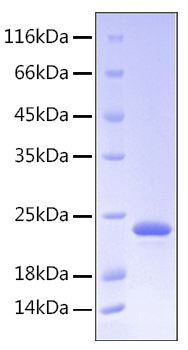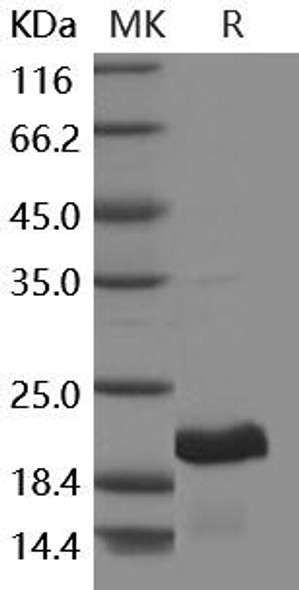Description
Recombinant Human Somatotropin/GH-N/GH1 Protein
The Recombinant Human Somatotropin/GH-N/GH1 Protein is a biologically active recombinant protein that plays a significant role in various cellular processes and signaling pathways in human biology. This protein is widely employed in immunological research, cell biology studies, protein-protein interaction analyses, and therapeutic development, providing researchers with a reliable tool for investigating Somatotropin/GH-N/GH1 function and its implications in health and disease.
This product (SKU: RPCB0180) is produced using E. coli and features a C-His tag for convenient detection and purification. The protein exhibits a calculated molecular weight of 22.97 kDa with an observed molecular weight of 23 kDa under denaturing conditions, achieving ≥ 90 % as determined by SDS-PAGE.. Functional bioactivity has been validated through rigorous quality control assays, confirming its suitability for demanding research applications.
Key Features
| High Purity by Affinity Chromatography | |
| Mammalian & Bacterial Expression Systems | |
| High lot-to-lot consistency via strict QC |
| Product Name: | Recombinant Human Somatotropin/GH-N/GH1 Protein |
| SKU: | RPCB0180 |
| Size: | 10 μg , 20 μg , 50 μg , 100 μg |
| Reactivity: | Human |
| Synonyms: | GH1, GH, GH-N, GHB5, GHN, IGHD1B, hGH-N, somatotropin, GH, GH-N, GHB5, GHN, IGHD1B, hGH-N |
| Tag: | C-His |
| Expression Host: | E. coli |
| Calculated MW: | 22.97 kDa |
| Observed MW: | 23 kDa |
| Gene ID: | 2688 |
| Protein Description: | High quality, high purity and low endotoxin recombinant Recombinant Human Somatotropin/GH-N/GH1 Protein (RPCB0180), tested reactivity in E. coli and has been validated in SDS-PAGE.100% guaranteed. |
| Endotoxin: | < 0.1 EU/μg of the protein by LAL method. |
| Purity: | ≥ 90 % as determined by SDS-PAGE. |
| Formulation: | Lyophilized from a 0.22 μm filtered solution of 20mM Tris, 150mM NaCl, pH 8.0.Contact us for customized product form or formulation. |
| Bio-Activity: | Measured by its binding ability in a functional ELISA. Immobilized Human GH1 at 2 μg/mL (100 μL/well) can bind Human GHR with a linear range of 0.1-19.4 ng/mL. |
| Reconstitution: | Centrifuge the vial before opening. Reconstitute to a concentration of 0.1-0.5 mg/mL in sterile distilled water. Avoid vortex or vigorously pipetting the protein. For long term storage, it is recommended to add a carrier protein or stablizer (e.g. 0.1% BSA, 5% HSA, 10% FBS or 5% Trehalose), and aliquot the reconstituted protein solution to minimize free-thaw cycles. |
| Storage: | Store at -20℃.Store the lyophilized protein at -20℃ to -80 ℃ up to 1 year from the date of receipt. After reconstitution, the protein solution is stable at -20℃ for 3 months, at 2-8℃ for up to 1 week. |
Growth hormone (GH), also known as somatotropin, is a member of a family of growth factors that includes prolactin, placental lactogens, proliferins, and somatolactin. It is synthesized primarily by somatotropes in the anterior pituitary and is stored in secretary granules. The pulsatile release of GH into circulation is regulated by the concerted actions of the hypothalamic hormones - GH-releasing hormone (GHRH) and somatostatin (SST) - as well as by signals from the periphery - ghrelin and leptin. Human GH is a pleiotropic cytokine that exerts its biological actions by binding to the transmembrane GH receptor, which is present in many cell types. GH stimulates the liver and other tissues to produce IGF-1, which regulates growth and metabolism. GH has also been shown to have direct effects on growth that is independent of IGF-1. GH, directly or indirectly via IGF-1, can act on B cells, T cells, NK cells, macrophages and neutrophils to exert immunomodulatory activities. In addition, GH can act directly on various cell types to induce lipolysis, lactation, amino acid uptake and protein synthesis.








